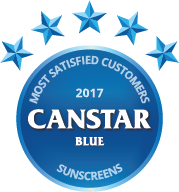2017 Sunscreens
You are viewing the archived Sunscreen ratings. Follow the link to view the current sunscreen rating page.
Compare sunscreens in New Zealand at Canstar Blue. Neutrogena, Banana Boat, Cancer Society, Nivea and SunSense were compared on value for money, texture and consistency, effectiveness, smell, ease of dispensing, ease of absorption and overall satisfaction.
See our Ratings Methodology
Save your skin – slop on the sunscreen
You wouldn’t get into a car without buckling up, you know the risks, right? So why would you go out in the sun without slapping on the sunscreen?
Unfortunately many Kiwi’s still think it’s okay to expose their unprotected skin to the harsh New Zealand sun – in fact in a recent Canstar Blue survey (May 2017) an astonishing 41% of people admitted they often go out in the sun without sunscreen on – and it’s this type of behaviour that has contributed towards New Zealand becoming the Melanoma capital of the world. That’s not a world title you want to own.
Skin cancer in New Zealand is a big problem. Around 69,000 new diagnoses are made every year and melanoma, the most serious type, affects 50 out of 100,000 people. In a country with a population of around 4,500,000, that’s 2,250 people every year who are facing a serious or terminal illness that, in many cases, could have been avoided.
What can Kiwis do to protect themselves against skin cancer?
Quite a bit as it goes.
Kiwis are known for their love of the outdoors, but we’ve got to bear in mind that those long summer days we all love so much are exposing us to UV rays – the harmful bits of sunlight. In addition, here in New Zealand UV is approximately 40% more harmful than is some other parts of the world, so we need to dress the part.
Hats are a great idea as they protect your head and can provide shade for the face. Dark coloured tops (preferably long sleeved), tee-shirts and rash vests can also offer protection – especially if they are made of a tightly woven fabric. The real stellar is clothing made with ‘built in’ Sun Protection Factor (SPF) and you should be looking for something that is at least SPF 30.
Even with hats (of which 24% of Kiwis say they don’t wear) and appropriate clothing, our primary line of defence should be a good sunscreen, also sometimes called sunblock.
How does sunscreen work?
Sunscreen works in two ways. Firstly it ‘reflects’ UV rays away from your skin, and in addition (and without getting too sciency) it can also absorb some of the UV radiation, further protecting your skin.
There are two types of damaging UV rays. The first, UVA, penetrate deep into your skin and are responsible for causing signs of ageing such as wrinkling and age spots. The second type of UV ray, UVB is the one responsible for sunburn and it’s these rays that sunscreen protects you from.
All sunscreens have a SPF which is an indication of how long it will protect your skin from (UVB) burning. For example, if burn time is estimated to be 10 minutes and you use an SPF 30 sunscreen, your protection time will be 300 minutes or 3 hours and 20 minutes. Don’t take this figure at face value though. Sweating or water activities can easily wash off your sunscreen so you should always apply generous helpings at regular intervals, around every two hours. In New Zealand an SPF of at least 30 is recommended as this will protect you against approximately 97% of UVB rays. Unfortunately there’s no sunscreen that can yet protect you against UVA, hence the importance of covering up with tops, hats and sunglasses in the sun.
What do we look for in our sunscreen?
Obviously the whole point of wearing sunscreen is to protect your skin against the sun’s damaging rays so it’s no surprise that effectiveness was the most valued attribute in our survey. But what else did people rate?
Packaging and ease of dispensing was next on the list. To aid application and absorption, sunscreen is naturally a creamy and sometimes even greasy product but this doesn’t help if you are struggling to get the top off, keep hold the bottle or spay it onto a wriggling child. Obviously we want something that’s quick, easy and fuss free.
Texture, consistency and ease of absorption were next on the list. It’s recommended that you put sunscreen on at least 20 minutes before going outside so you don’t want to have to stand around waiting for the stuff to dry, or worst still, go out with lovely white streaks all over your arms, legs and face!
Scent was also pretty low on the list but the final category is value for money. As this is the least important attribute when it comes to overall satisfaction, we suspect that people are prepared to pay for a product that works for them.
If you want to find out more about staying safe in the sun, visit sunsmart.org.nz
Frequently asked questions
Canstar Blue commissioned I-view to survey 2,500 New Zealand consumers across a range of categories to measure and track customer satisfaction. The outcomes reported are the results from customers who have purchased and used sunscreen in the last 12 months – in this case, 1,589 New Zealanders.
Brands must have received at least 30 responses to be included. Results are comparative and it should be noted that brands receiving three stars have still achieved a satisfaction measure of at least six out of 10. Not all brands available in the market have been compared in this survey. The ratings table is first sorted by star ratings and then alphabetically. A rated brand may receive a ‘N/A’ (Not Applicable) rating if it does not receive the minimum number of responses for that criteria.


